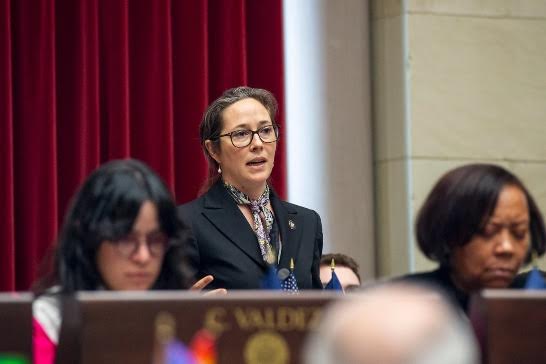Legislation Expands Access to Modern Septic Systems, Protecting Groundwater and Waterways Across New York
In a major environmental and affordability win, Assemblywoman Rebecca Kassay announced the unanimous passage of her legislation (A8807/S8241-A) in both the New York State Assembly and Senate. The bill updates the reimbursement structure of the New York State Septic System Replacement Fund, making it easier and more affordable for New Yorkers to upgrade to advanced septic systems that significantly reduce water pollution, according to a press release.
The legislation increases the reimbursement rate to 75% of eligible costs, up to $25,000 per project, enabling more homeowners to install “clean water” septic systems that remove nitrogen, phosphorus, and other harmful contaminants before they reach groundwater, bays, harbors, lakes, and rivers– and the taps of the 8 million residents of Long Island. Assemblywoman Kassay stated, “Most New Yorkers want to do their part to protect our environment, but sometimes budgetary restrictions prevent families from making those efforts. I am proud to deliver legislation that not only further protects our water, but also addresses affordability issues.”
Outdated or failing septic systems are a major source of nutrient pollution across New York, contributing to harmful algal blooms, fish kills, and water quality degradation. While advanced septic technologies are significantly more effective at treating wastewater, their cost often puts them out of reach for many families—unless supported by state funding.
Environmental and public health advocates praised the bill’s passage as a vital step toward reducing pollution and advancing clean water infrastructure.
Adrienne Esposito, Executive Director, Citizens Campaign for the Environment, said, “This critical legislation will be a catalyst for the public to be financially incentivized to replace their old, antiquated polluting cesspools and septic systems. No longer can we allow inadequately treated sewage, nitrogen pollution, and other contaminants to flow from our septic systems and enter into groundwater and our harbors, bays, rivers, lakes, and beaches. These grants will provide substantive financial assistance to allow people to make the change! The replacement program is already very popular with the public; however, this increase in funds will galvanize residents who were reluctant to make the switch because they needed a bit more financial help to act. We are very excited that this law got passed and thank Senator Harckham and Assemblywoman Rebecca Kassay for getting it done!”
Kevin McDonald, Senior Policy Advisor, The Nature Conservancy, added, “Pollution from traditional septic systems harms wildlife and threatens clean drinking water across our state. On Long Island, the problem is especially severe where nitrogen pollution is harming our bays, harbors, and drinking water supply. To restore clean water and protect public health, we need to support property owners in upgrading septic systems with technology that can treat nitrogen pollution. The Nature Conservancy applauds the Senate and Assembly for passing legislation to enhance the state’s Septic System Replacement Fund, which will ensure clean water septic systems are within financial reach of more property owners. Thank you to bill sponsors Senator Pete Harckham and Assemblymember Rebecca Kassay for championing this important policy change and to Governor Kathy Hochul and the Environmental Facilities Corporation for advancing this important grant program.”
The legislation builds on New York’s Clean Water Infrastructure Act and supports the long-term protection of drinking water supplies, recreational waterways, and marine habitats in regions such as Long Island, the Finger Lakes, and the Thousand Islands. “The passage of this legislation is another important step toward cleaner waters in, on, and around Long Island. Both our drinking water supply and the surrounding coastal waters will benefit from the legislation as homeowners are provided with significant additional financial incentives to install nitrogen reducing, state-of-the-art sanitary systems at their residences,” stated John Turner, Senior Conservation Policy Advocate, Seatuck Environmental Association. “We have no doubt that when this bill becomes law more Long Islanders will participate in efforts to safeguard their ground- and coastal waters. Kudos to Assemblymember Kassay for her leadership in sponsoring this critically important environmental protection measure,” John Turner concluded.
“In Suffolk County, the state’s largest county outside of New York City, there are over 380,000 outdated cesspools and septic tanks in use,” stated Assemblyman Tommy John Schiavoni. “Many of them are located in my district on the East End of Long Island. Onsite wastewater treatment systems reduce the amount of effluent and pollutants expelled into the environment, reducing the amount of nitrogen and phosphorus into surface and drinking waters, including Long Island’s sole-source aquifer. A.8807 falls in line with the priorities and needs of Long Island, and the environmental goals for the great State of New York. I commend the Senate and Assembly sponsors of A.8807, the Department of Environmental Conservation, and the Governor for the increased attention to the need for modernizing residential wastewater management across the state.”
The bill’s next step is for Governor Hochul to sign and chapter it, which could take place in the coming weeks or months. Strongly motivated by the environmental and affordability benefits of this legislation, Assemblywoman Kassay will continue to work with her colleagues in government and environmental advocates to ensure that this bill is signed into law.





